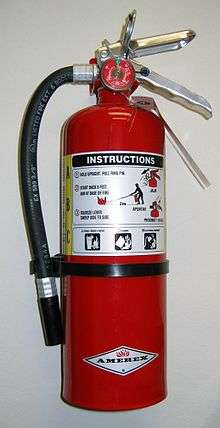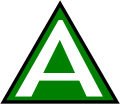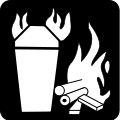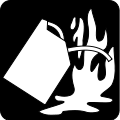ABC dry chemical

Monoammonium phosphate, ABC Dry Chemical, ABE Powder, tri-class, or multi-purpose dry chemical is a dry chemical extinguishing agent used on class A, class B, and class C fires. It uses a specially fluidized and siliconized monoammonium phosphate powder. ABC dry chemical is usually a mix of monoammonium phosphate and ammonium sulfate, the former being the active one. The mix between the two agents is usually 40–60%, 60-40%, or 90-10% depending on local standards worldwide. The USGS uses a similar mixture, called Phos Chek G75F.[1]
Uses
Common combustible solids
It insulates Class A fires by melting at approximately 350–400 degrees F. Class "A" fires are caused by the burning of common combustible materials, such as wood, paper, or most plastics.[2]
Burning liquids and gases
The powder breaks the chain reaction of liquid and gas fires by coating the surface to which it is applied. These fires (Class B in the American system; Classes B and C in the European and Australian systems) include the burning of gasoline, oil, propane, and natural gas.
Electrical fires
It is safe and effective for electrical fires since it is a non-conductor of electricity. Fires involving live electrical equipment (Class C in the American system; Class E in the Australian system) need to be put out with equipment that will not conduct its energy back to the user as is the case with water. Electricity can also cause fires of the other classes.
Inappropriate uses
ABC dry chemical is inappropriate for chlorine or oxidizer fires.[3] The resulting chemical reaction can cause an explosion or a breakdown of the chemicals releasing toxic gases. Water should be used in that case.[4][5]
ABC dry chemical is inappropriate for certain metal fires (Class-D) as well as cooking oil fires (Class-K).
Due to the corrosive properties of ABC Dry chemical, it is not recommended for use around aircraft or sensitive equipment.
Chimney bombs
Chimney bombs are zip-lock bags or other small bags filled with ABC dry chemical powder. Chimney bombs are used by fire service personnel to help extinguish chimney fires. Creosote, which is the by-product of the incomplete burning of wood (typically due to chronic combustion-air insufficiency), is extinguished by the chain reaction caused by the chimney bombs. Chimney bombs work by first being dropped directly down a chimney, where upon contact with the flue bottom and heat of the fire, they explode, thereby releasing the powder. Then, the natural chimney draft will carry the dry chemical powder up the shaft of the chimney, thus coating the creosote and eventually neutralizing the fire. Use of multiple chimney bombs may be necessary, depending on how severe the fire is. Chimney bombs can also be effective if they are opened and then dropped down the chimney. In order for chimney bombs to be effective, it may be necessary to first unclog the chimney.[6][7]
| Fire class (US) | Geometric symbol | Pictogram | Intended use | Mnemonic | Compatibility | |
|---|---|---|---|---|---|---|
| A |  |  | Ordinary solid combustibles | A for "Ash" | Compatible | |
| B |  |  | Flammable liquids and gases | B for "Barrel" | Compatible | |
| C |  | | Energized electrical equipment | C for "Current" | Compatible | |
| D | | (none) | Combustible metals | D for "Dynamite" | Not compatible | |
| K |  | | Oils and fats | K for "Kitchen" | Not compatible |
References
- ↑ "Ecological Effects of Fire Retardant Chemicals and Fire Suppressant Foams". Archived from the original on 2007-08-18. Retrieved 2011-02-16.
- ↑ http://www.falckproductions.com/resources/fire-safety-and-firewatch/classes-of-fire-a-b-c-d-and-k/
- ↑ "Selection of Fire Extinguishers for Fires Involving Oxidizers (Swimming Pool Chemicals)". Retrieved 2008-09-13.
- ↑ "Chlorine facts". Archived from the original on 2008-04-30. Retrieved 2008-09-13.
- ↑ "Sprinkler protection for swimming pool chemicals". NFPA Journal. 2004. Retrieved 2008-09-13.
- ↑ "Fire Engineering". Retrieved 2013-02-27.
- ↑ "Chimney Bombs". Retrieved 2015-10-19.
External links
| Wikimedia Commons has media related to Fire extinguisher. |